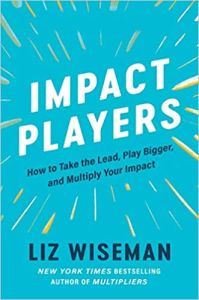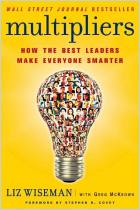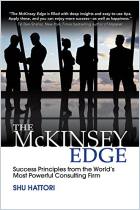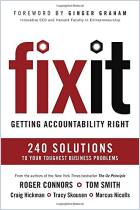加入 getAbstract 阅读摘要

加入 getAbstract 阅读摘要
Liz Wiseman
Impact Players
How to Take the Lead, Play Bigger, and Multiply Your Impact
HarperBusiness, 2021
看看什么内容?
Become a top contributor on your team by adopting the mind-set and behaviors of high-impact performers.
Recommendation
Many professionals excel in their jobs, yet a few rise above the rest. Leaders struggle to identify the differentiators that separate high-impact employees from their equally capable peers. Talent development professional Liz Wiseman draws on her experience to unravel the mind-set of top performers. She helps you recognize them, and teaches you the practices that will make them – and you – vital players in your organization.
Take-Aways
- Impact players find the most valuable way to contribute their capability at work.
- Practice One: Do the job that’s needed.
- Practice Two: Step up and take the lead, then step back and support others.
- Practice Three: Finish stronger.
- Practice Four: Ask and adjust.
- Practice Five: Make Work Light.
- Discover the foundational skills of impact players.
Summary
Impact players find the most valuable way to contribute their capability at work.
Impact players are the standout contributors who create extraordinary value. Leaders tend to know who these high-impact employees are but often struggle to pinpoint what separates them from their equally capable peers. Insights from leaders at top companies help understand what the most influential players are doing differently, how small differences in the way people think and act can make an enormous impact and why, with a little coaching, this mind-set is available to everyone who wants to perform at their peak.
“Some people seem to know how to make themselves valuable. They pay attention. They look for the most productive places to put their capability to use.”
To understand these differentiators, researchers asked managers at nine top companies to describe three types of employees:
- High-impact contributors: those who do work of exceptional value and impact.
- Typical contributors: Those who produce solid, steady work. They work hard, perform well and earn high praise from their managers.
- Under-contributors: Those who perform below their capacity and capabilities.
The interviews with these managers exposed differences that enable high-impact contributors to go beyond capability and hard work. Behaviors common among high-impact professionals include how they react to uncertainty or events they cannot control, and how they see opportunities – not threats – in workplace challenges. Research identifies five practices that impact players demonstrate.
Practice One: Do the job that’s needed.
When dealing with complex problems, impact players address the real needs of the organization. They venture beyond their assigned job to tackle the real task that needs to be done.
“Impactful players don’t just do their jobs; they do the job that’s needed.”
Impact players aim to serve. This orientation prompts them to empathize with their stakeholders, look for unmet needs and focus where they are most useful. To embrace the habits of impact players, do the following:
- Understand your organization’s goals and culture – Learn what makes an impact.
- Look for a double “WIN” (“What’s Important Now”) – Look for something important to the organization that’s also important to your immediate boss (or stakeholder). Then look for an opportunity to contribute where your capabilities overlap with the WIN. Maximize your impact by identifying a WIN that is one of your stakeholder’s top three priorities.
- Work with purpose – High-impact players bring passion to their jobs and the tasks they need to do, not to their particular areas of interest or specialty topics.
While most employees work diligently, impact players see the larger picture and apply themselves where they have the greatest effect. Habits that impede even the hardest workers include:
- Focusing only on their job descriptions – Obsessing over their place in the organizational chart causes them to miss the organization’s top priorities.
- Playing only to their passions – Managers need employees to work toward the organization’s priorities and to direct their passion to what needs doing.
Practice Two: Step up and take the lead, then step back and support others.
Some problems don’t loom large in leaders’ minds, but they still cost companies time and money. Signs that these ambient problems exist in your organization include intermittent complaints, a lack of ownership of projects and needing workarounds for employees to complete their tasks.
Typical contributors deliver on their tasks and produce solid work, but sometimes miss their mark. Behaviors that impede these workers include:
- Waiting for an invitation – When you want more responsibility, step in and take the lead. Teams of bystanders do not thrive.
- Creating a team of equals – Collaborative teams are great, but they need direction. When taking the lead, communicate your intentions to your teammates (what you aim to accomplish and how it benefits the organization), and ask for their cooperation. Willingly share power and credit for your accomplishments.
“If you want to maximize your value, look for the quietly persistent problems and take initiative to solve them. Look for leadership vacuums and fill them.”
Impact players step up. Adopt these habits of high-impact contributors:
- Take a leadership role – You don’t need to manage a project to take initiative. Project manager Ellie from Target, for example, discovered a problem in the technology set up for all the stores. She gathered everyone involved, illuminated the problem and resolved the issue that had persisted for months in thirty minutes.
- Enlist others – Break down the challenges of a project and recruit others to help.
- Step back – Share the accolades with others on your team and follow others when they take on projects.
Practice Three: Finish stronger.
All projects encounter obstacles. Some you know well in advance, but many prove impossible to predict. COVID-19, for example, rocked organizations and schools around the globe, and many companies and project teams found themselves quickly shifting priorities. Impact players recognize that all projects encounter hurdles and regard these challenges as opportunities. They refuse to remain stymied. Habits of high-impact players call on you to:
- Finish the whole job – Leaders know impact players complete their projects despite challenges and rely on them for their highly visible, pressing priorities.
- Maintain ownership – High-impact employees lead and retain responsibility throughout the project. They know when to ask for help, and ensure they have the tools and support they need to do the job.
- Prepare for challenges – Dr. Kevin Menes, the lead physician in a Las Vegas hospital emergency room, knew that, at some point, the city would experience a mass casualty incident, and he diligently prepared for it. Impact players prepare for unknown hurdles and find effective solutions in advance.
Impact players assume responsibility and accountability. Behaviors that impede less-effective employees include:
- Finishing for the sake of finishing – Some projects lose relevance in today’s shifting priorities. The high-impact player knows when to let go of an unproductive project.
- Sounding false alarms – When people see problems as threats, they often can be too quick to sound the alarm, which dilutes influence and credibility. Beware of overcommunicating problems and underdelivering solutions.
The best players see things through. They complete what they start. When you take on a new project, accept that problems will arise. Approach these with resilience and finish stronger.
Practice Four: Ask and adjust.
Impact players adapt to changing conditions faster than their peers because they interpret new rules and new targets as opportunities for learning and growth. While they appreciate affirmation and positive feedback, they actively seek corrective feedback and contrary views and use it to recalibrate and refocus their efforts.
“The most valuable players are never finished. They are continually adapting, adjusting to hit the mark.”
While others attempt to manage and minimize change, impact players are learning and adapting to change. To embrace the habits of these impact players:
- Seek guidance – Managers respond well to coachable employees. Impact players ask for feedback, not validation, and incorporate criticism into their work.
- Adjust – One Salesforce employee, for example, took pride in his technology designs, but often had a defensive relationship with his peers when they offered feedback. As he responded more positively to criticism, he enhanced his ability to work with others and design more effective products.
- Return – When impact players receive guidance, they close the loop by showing their mentors the positive results of their investment.
Impact players adjust to changing environments and understand that constructive feedback increases their effect. Typical contributors prefer stability and prove risky in today’s dynamic business climate.
These practices impede lower performers:
- Sticking to what they know – Instead of changing with priorities, less-effective workers focus on their strengths and fail to adjust.
- Portraying an air of confidence – Instead of asking for guidance, these employees refrain from reaching out and discovering alternative approaches. By asking for guidance, you increase, not decrease, your credibility and your manager’s confidence in you.
Practice Five: Make Work Light.
When increased pressure and unrelenting demands weigh down a team, impact players make hard work easier. They reduce workplace stressors by being easy to work with and avoiding drama and politics. By creating a positive and productive work environment for everyone, they reinforce a culture of collaboration and inclusion, and develop a reputation as high-performing, low-maintenance players.
Adopt these habits of high-impact contributors:
- Require minimal oversight – High-impact workers do the job with minimal supervision because they are low maintenance. They come prepared to meetings and stand ready to help.
- Lighten the workload and the work environment – High performers know how to help busy managers by finding ways to ease their workload. Keeping the mood light, they help their teams perform well.
When the pressure is on and workloads are at a peak, typical contributors tend to seek help rather than offering to help. As this becomes the default response, these employees add to the burden of already over-taxed teams during difficult times. Impact players make heavy demands feel lighter.
Discover the foundational skills of impact players.
Two underlying competencies differentiate high performers from typical contributors and make adopting impact-player behaviors easier. Impact players know to adjust their:
- Perspective – High-impact employees can take others’ viewpoints into account. While typical professionals assess a situation and act, they may end up missing something if they only see it from their own point of view. Impact players step back and examine the issue from other angles, to expand their understanding before taking action.
- Lens – Seeing everyday challenges through an opportunity lens, not a threat lens, makes the impact player an asset. An impact player knows how to add value when facing difficult situations.
As a manager, build a team of impact players – employees who are not just capable and driven, but curious and coachable. When recruiting, look for low-maintenance workers who embrace ambiguity and respond well to feedback. You can explore, for example, how a candidate reacted to a difficult situation, and whether they saw it as an opportunity to add value. Similarly, you can ask a candidate to share his or her views of a project from a customer perspective.
When inheriting a team, leaders grow talent from within. Adopt these habits as you coach your employees:
- Work on the WIN.
- Re-characterize what leadership means in an agile world.
- Ask your employees to finish one project before moving to another.
- Critique the work not the person.
- Let your employees know what makes your job easier.
To actively promote impact-player behavior, call attention to specific actions and encourage collaboration among teammates. Celebrate your team’s valuable and self-directed contributions. If you do, you will build a team of high-impact players – and a culture of cooperation and initiative, with confident employees who excel in this agile world.
About the Author
Former corporate executive and author of Multipliers and Rookie Smarts Liz Wiseman leads The Wiseman Group, a leadership research and development firm.
This document is restricted to personal use only.





















Comment on this summary